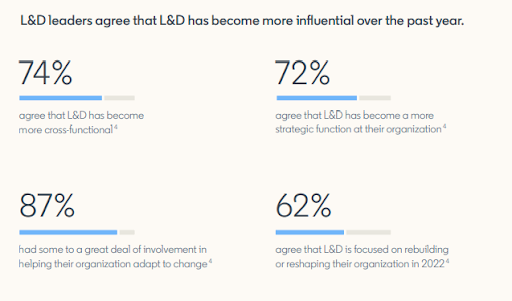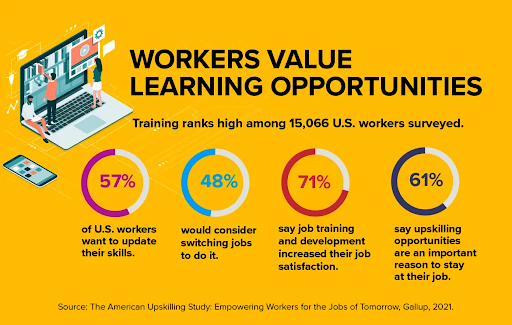What is L&D meaning for an organization? A successful learning and development strategy combines different learning opportunities, such as social learning and different learning styles.
Amid this era of massive transformation, learning and development has a new mandate to improve.
L&D leaders are continually answering employees’ calls for growth and purpose while grappling with the challenge of future-proofing their organizations.
Its importance is undeniable.
In 2022, L&D pros saw 15% more promotions than their HR counterparts.
Additionally, 64% saw their organization’s learning culture grow stronger in the past year.
What Should An L&D Strategy Include?
It should include initiatives that motivate employees to learn new skills and knowledge relevant to their job role and to the organization as a whole.
In order for the learning and development strategy to be successful, it must leverage modern technologies and facilitate collaboration among employees while also providing feedback on performance.

All in all, a successful learning and development strategy can be achieved by actively engaging employees in meaningful ways, offering them relevant learning opportunities, and providing them with the necessary resources to succeed.
Top Considerations For A Successful Learning And Development Strategy
#1 Does It Align With Your Overall Business Strategy?
Alignment with overall business strategy is a key consideration when making any decision.
It is important to ensure that all decisions being made are in line with the overall objectives of the business.
This means making sure that resources are being used efficiently and that decisions are helping to achieve the long-term goals of the organization.
Taking into account how a choice will impact the larger business allows for more informed decision-making, which can lead to greater success and growth.
Aligning each corporate learning decision with its mission and vision sets up an environment where progress can be made, as every action taken is in support of what the company stands for.
#2 Have You Considered Organizational Priorities?
Depending on the organization’s goals and objectives, the L&D strategy should be tailored accordingly.
For example, if the organization has set a goal to increase employee engagement, then the learning strategy should focus on activities such as team-building exercises or meetings that enable employees to build relationships and feel more connected with their work.
On the other hand, if the organization wants to improve its skills development, the strategy should include training initiatives such as seminars or workshops that help employees acquire new skills or update existing ones.
Further, organizations should also consider budget constraints when formulating an effective strategy, as this will impact what types of activities can be implemented.

#3 What Available Corporate Learning Tools & Techniques Do You Possess?
These tools should be suitable for both individual learners and groups, as well as for online or offline delivery.
They should also be tailored to the specific environment of the company so that they can be effectively used by employees.
Examples of these tools include
- e-learning platforms,
- virtual classrooms,
- mobile apps,
- webinars,
- video conferencing,
- and collaboration tools.
Additionally, there should be an emphasis on providing a diverse range of learning opportunities so that learners can gain knowledge in areas that are relevant to their current roles.
By having access to these corporate learning tools and techniques, companies can ensure that their employees are able to develop their skillsets efficiently and keep up with changes in the workplace.
#4 Have You Considered Employee Recruitment & Retention Rate in Your Strategy?
A good L&D strategy will include onboarding programs, training opportunities, and regular performance reviews to ensure that employees feel engaged and valued.
Recruiting the right people with the right skills and attitudes will ensure that they are set up for success in their roles.
In addition, offering competitive salaries, flexible working arrangements and career progression opportunities can help to improve retention rates.
By focusing on both recruitment and retention, businesses can ensure that they have a strong workforce that is well-equipped for success in the future.
Bottom line – Future Proof Your Learning Strategy
For a successful Learning and Development (L&D) strategy, it is important to consider the future requirements.
This means revisiting the current processes and assessing if they are meeting the future needs of the organization.
It might involve creating a roadmap of training programs and initiatives to ensure that employees have the right skills to meet their future roles.
Finally, it is important to ensure that the strategies are regularly monitored and evaluated so that improvements can be made as needed.
By taking these steps into consideration, organizations can create a successful L&D strategy for years to come.
To learn more about learning strategies and how to grow your business, click here.

